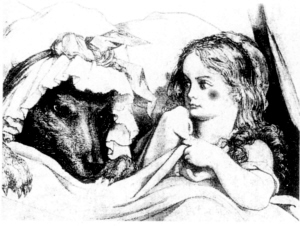As a cultural heritage from ancient times to the present-day, folklore retains its vigor and vitality by retelling them again and again. Folk tales have inspired literature, architecture, movies, and all kinds of art. Encountered with the huge volume of folk tales, I am going to explore "Little Red Riding Hood", a world-known fairy tale familiar to everyone.
According to the preeminent French folklorist Delarue, "Little Red Riding Hood" originated as an oral tale during the medieval times in Europe, where the dominant note was agriculture. In the freezing winter nights, folks in the fields would gather around a great fire to keep themselves warm while listening to each other's stories to pass the time. Most of these fireside stories depicted hunger, infanticide and abandonment, which were pervading the poverty-ridden Europe at that time. Under these circumstances, the oral tale of "Little Red Riding Hood" was composed of a succinct and concise dialogue and it ended with the little girl rescuing herself by using her own wits and courage, reflecting the ideal female image in old times as an independent and capable woman, with some traces left from the matriarchal society.
"Little Red Riding Hood" gradually entered the printing world and became a fixed story collected or written by individual scholars and writers. Charles Perrault is perhaps the first scholar who used the story of "Little Red Riding Hood" in his book Tales of Times Past with Morals, published in 1697. Perrault felt that his contemporaries from the French court ruled by the notorious Sun King, Louis X IV were corrupted so he was determined to cultivate appropriate conduct codes among the young, especially the young ladies. In Perrault's version, Little Red Riding Hood becomes a gorgeous young lady who is fooled and consumed by the big wolf, indicating the sexual scandals about the court. Hence, Perrault adds a moral to the end of the story, warning the young women against their sexual desire, as well as the young gentlemen. Perrault turned this nursery tale into a sexual fable, hoping to bring back morals to the French court and to consolidate the patriarchal standards concerning virginity imposed on the female body.

The cover for Tales of Times Past with Morals
About a century after Perrault's retelling of the story, "Little Red Riding Hood" crossed the border and made its way into the German nurseries - the Brothers Grimm added this story to their founding fairy tale collection, notwithstanding their pruning so as to cater it toward the children. After strict editing, it was transformed from a sexual moral to a family fable where the heroine became an innocent girl tempted by attraction and was rescued by a hunter, the symbol of a father. This story propagates the patriarchal ideology that children should obey their parents or guardians and that women, especially young girls, helpless and vulnerable as they are, should always count on the man to rescue and support them.
From the twentieth century on, more and more writers joined in the retelling of this fairy tale. Among these writers were Anne Sexton, who criticized the cliches and lies; Angela Carter, who deconstructed and subverted the patriarchal order; and Roald Dahl, who satirized the extreme feminism and consumption culture. Following these great writers was an even larger group of post-modernists who built their own beliefs and values through rewriting "Little Red Riding Hood" and through adapting it onto the silver screen.
Through the case study of "Little Red Riding Hood", we can safely conclude that folk tales reflect the current culture and social standards. They mirror the social codes and the collective fantasy, and they strengthen gender stereotypes; meanwhile, they also invite all kinds of possibilities to society and challenge, or even subvert the social norms. Folk tales evolve along with history and bring in revolution at the same time.
This stands original

